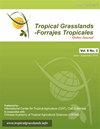Effects of different supplements on performance of steers grazing Mombaça guineagrass (Megathyrsus maximus) during the dry period
IF 0.7
4区 农林科学
Q3 AGRICULTURE, DAIRY & ANIMAL SCIENCE
引用次数: 4
Abstract
To mitigate the low animal performance on Mombaça guineagrass pasture during the dry period, feeding 2 types ofsupplement to 2 genetic groups was evaluated. The experimental design was a randomized block design following a 2 ×2 factorial arrangement with 4 replications. The treatments consisted of feeding 2 levels of supplement (0.25 and 1.0% of body weight; BW), named low-cost supplement (LCS; US$ 11.75/steer) and high-cost supplement (HCS; US$ 62.80/steer), respectively, for 130 days (July–October; dry season) to 2 genetic groups: Caracu and F1 Senepol × Caracu. The steers were supplemented daily and weighed every 28 days. Pastures were evaluated monthly to estimate the herbage accumulation rate, herbage mass (HM), leaf, stem and dead material percentages and nutritive value. HM, morphological components and nutritive value were independent of supplement type fed (P>0.05). There were decreases in HM (3,720 to 3,205 kg DM/ha), daily herbage allowance (14.0 to 9.4 kg DM/100 kg BW) and leaf percentage (33.4 to 21.2%) and increase in dead material percentage (53.3 to 67.7%) throughout the experimental period. In vitro organic matter digestibility (59.9%), crude protein concentration (10.0%), neutral detergent fiber (72.1%) and acid detergent lignin (2.9%) remained constant from July to September but increased markedly in October. Steers supplemented with HCS performed better (P<0.05) than those which received LCS (1.005 vs. 0.565 kg liveweight gain/head/day, respectively). Regardless of supplement type, F1 Senepol × Caracu steers had greater average daily gains than pure Caracu steers (0.88 vs. 0.71 kg/hd/d, respectively). Feeding HCS to steers in the dry season would produce better performance than LCS and could reduce time to reach slaughter weight but weight changes during the subsequent wet season should be monitored to assess the extent of any compensatory gain by the low-cost group during this period to reduce the weight advantage of the high-cost group.干旱期不同补料对Mombaça guinegrass(Megathyrsus maximus)放牧公牛生产性能的影响
为了缓解Mombaça guineagrass牧场在干旱期的低动物性能,对2个遗传群喂食2种类型的苹果进行了评估。实验设计为随机分组设计,遵循2×2析因安排,4次重复。处理包括向2个遗传群(Caracu和F1 Senepol×Caracu)分别喂食2种水平的补充剂(体重的0.25%和1.0%;BW),分别命名为低成本补充剂(LCS;11.75美元/头)和高成本补充剂(HCS;62.80美元/只),持续130天(7月至10月;旱季)。每天补充一次,每28天称重一次。每月对牧场进行评估,以估计牧草积累率、牧草质量(HM)、叶、茎和死料百分比以及营养价值。HM、形态成分和营养价值与补饲类型无关(P>0.05),试验期间HM(3720~3205kg DM/ha)、日采食量(14.0~9.4kg DM/100kg BW)、叶率(33.4%~21.2%)下降,死料率(53.3%~67.7%)上升。有机物体外消化率(59.9%)、粗蛋白浓度(10.0%)、中性洗涤剂纤维(72.1%)和酸性洗涤剂木质素(2.9%)在7-9月保持不变,但在10月显著增加。补充HCS的牛比接受LCS的牛表现更好(P<0.05)(分别为1.005和0.565公斤活重/头/天)。无论补充类型如何,F1 Senepol×Caracu公牛的平均日增重均高于纯Caracu牛(分别为0.88和0.71 kg/hd/d)。在旱季给公牛喂食HCS会比LCS产生更好的性能,并可以缩短达到屠宰重量的时间,但应监测随后雨季的重量变化,以评估低成本组在这段时间内的任何补偿增益的程度,从而降低高成本组的重量优势。
本文章由计算机程序翻译,如有差异,请以英文原文为准。
求助全文
约1分钟内获得全文
求助全文
来源期刊

Tropical Grasslands-Forrajes Tropicales
Agricultural and Biological Sciences-Agronomy and Crop Science
CiteScore
1.60
自引率
0.00%
发文量
36
审稿时长
16 weeks
期刊介绍:
The Journal publishes, in English or Spanish, Research Papers and Short Communications on research and development, as well as contributions from practitioners (Farmer Contributions) and Review Articles, related to pastures and forages in the tropics and subtropics. There is no regional focus; the information published should be of interest to a wide readership, encomprising researchers, academics, students, technicians, development workers and farmers.
In general, the focus of the Journal is more on sown (''improved'') pastures and forages than on rangeland-specific aspects of natural grasslands, but exceptions are possible (e.g. when a submission is relevant for a particularly broad readership in the pasture and forage science community).
The Journal will also consider the occasional publication of associated, but closely related, research in the form of an additional scientific communication platform [e.g. a re-make of the former Genetic Resources Communication series of the former Division of Tropical Crops and Pastures of the Commonwealth Scientific and Industrial Research Organisation (CSIRO), Australia].
Areas of particular interest to the Journal are:
Forage Genetic Resources and Livestock Production[...]
Environmental Functions of Forages[...]
Socio-economic Aspects[...]
Topics within the aforementioned areas may include: Diversity evaluation; Agronomy; Establishment (including fertilization); Management and utilization; Animal production; Nutritive value; Biotic stresses (pests and diseases, weeds); Abiotic stresses (soil fertility, water, temperature); Genetics and breeding; Biogeography and germplasm collections; Seed production; Ecology; Physiology; Rhizobiology (including BNF, BNI, mycorrhizae); Forage conservation; Economics; Multilocational experimentation; Modelling.
 求助内容:
求助内容: 应助结果提醒方式:
应助结果提醒方式:


